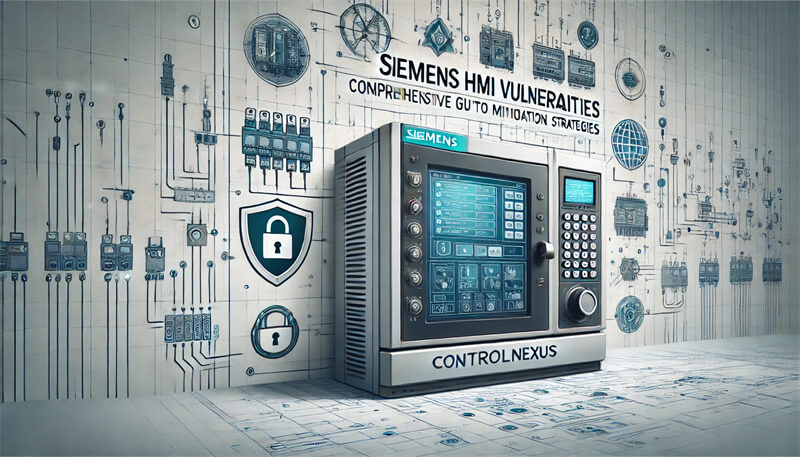Key Takeaways
| Question | Answer |
|---|---|
| What are Siemens HMI panels? | Siemens HMI panels are Human-Machine Interfaces used for operator control and monitoring of machines and plants. |
| What are the main vulnerabilities? | The main vulnerabilities include insufficiently protected credentials, improper input validation, and remote exploitation via Telnet service. |
| How severe are these vulnerabilities? | These vulnerabilities range in severity, with CVSS scores from 5.8 to 9.3, indicating moderate to high risk. |
| What products are affected? | Affected products include SIMATIC S7-1200, S7-1500, HMI Comfort Panels, KTP Mobile Panels, and more. |
| What mitigation strategies are recommended? | Recommended strategies include updating software, restricting network access, disabling vulnerable services, and implementing defense-in-depth strategies. |
Introduction
Siemens HMI panels play a crucial role in industrial automation, serving as the interface between operators and the machines they control. These panels are integral to the smooth operation of various industrial processes, making their security paramount. However, vulnerabilities in Siemens HMI panels can pose significant risks, potentially leading to unauthorized access, data breaches, and operational disruptions. This guide aims to provide a comprehensive understanding of these vulnerabilities and offer effective mitigation strategies to ensure the security and integrity of Siemens HMI panels.
Overview of Siemens HMI Vulnerabilities
Siemens HMI panels, like any other connected devices, are susceptible to various vulnerabilities. These vulnerabilities can be exploited by attackers to gain unauthorized access, cause disruptions, or extract sensitive information. Understanding these vulnerabilities is the first step toward mitigating the associated risks.
Detailed Breakdown of Specific Vulnerabilities
Insufficiently Protected Credentials (CVE-2022-38465)
One of the critical vulnerabilities affecting Siemens HMI panels is the issue of insufficiently protected credentials. This vulnerability impacts the SIMATIC S7-1200 and S7-1500 CPU families. Attackers can exploit this weakness by discovering the private key of a CPU product family through an offline attack against a single CPU. This knowledge can then be used to extract confidential configuration data or perform attacks against legacy PG/PC and HMI communication.
Impact
- Exposure of confidential configuration data
- Potential attacks on legacy systems
Improper Input Validation (CVE-2022-40227)
Improper input validation is another significant vulnerability that affects several Siemens HMI models, including the SIMATIC HMI Comfort Panels and KTP Mobile Panels. This vulnerability allows an unauthenticated remote attacker to cause a permanent denial-of-service (DoS) condition by sending specially crafted TCP packets. The affected devices fail to properly validate input sent to certain services over TCP, leading to potential disruptions.
Impact
- Permanent denial-of-service condition
- Requirement for device reboot
Remote Exploitation via Telnet Service (CVE-2020-15798)
This vulnerability involves the Telnet service, which, if enabled, does not require any authentication, allowing remote attackers to gain full access to the device. This vulnerability affects SIMATIC HMI Comfort Panels and SIPLUS products. While Telnet is not enabled by default, its presence poses a significant security risk if not managed correctly.
Impact
- Full remote access to the device
- Potential use of HMI as a foothold in targeted networks
- Possible disruption or manipulation of industrial processes
Risk Evaluation and Potential Impacts
Understanding the severity of these vulnerabilities is crucial for implementing effective mitigation strategies. The Common Vulnerability Scoring System (CVSS) scores provide a quantitative measure of the severity of these vulnerabilities:
- Insufficiently Protected Credentials: CVSS v3 score of 9.3, indicating a high risk.
- Improper Input Validation: CVSS v3 score of 7.5, reflecting a moderate to high risk.
- Remote Exploitation via Telnet Service: CVSS v3 score of 7.1, also indicating a significant risk.
These vulnerabilities can lead to various consequences, including unauthorized access, data breaches, denial-of-service conditions, and the potential for attackers to use compromised HMIs as entry points into industrial networks. In real-world scenarios, these vulnerabilities could result in substantial operational disruptions and financial losses.
Mitigation Strategies and Best Practices
Software Updates and Patches
Keeping Siemens HMI panels updated with the latest software versions is one of the most effective ways to mitigate vulnerabilities. Siemens regularly releases updates and patches to address known security issues. For instance:
- SIMATIC S7-1200 and S7-1500: Update to version 2.9.2 or later.
- SIMATIC HMI Comfort Panels: Update to V17 Update 4 or later.
- SIMATIC HMI KTP Mobile Panels: Update to V17 Update 4 or later.
Network Access Restrictions
Restricting network access to vulnerable ports can significantly reduce the risk of exploitation. For example, limiting access to ports 102/TCP, 5001/TCP, and 5002/TCP to trusted IP addresses can prevent unauthorized access and potential attacks.
Disabling Vulnerable Services
Disabling unnecessary services, such as Telnet, can eliminate potential attack vectors. Ensuring that only essential services are enabled and properly configured reduces the attack surface and enhances overall security.
Defense-in-Depth Strategies
Implementing multiple layers of security measures, known as defense-in-depth, can provide comprehensive protection against various threats. This includes using VPNs to secure network communications, applying the cell protection concept, and following Siemens' operational guidelines for industrial security.
Expert Insights and Recommendations
Understanding the vulnerabilities in Siemens HMI panels requires not only a technical perspective but also insights from industry experts. These insights can help us better appreciate the complexity and impact of these security issues.
Expert Quotes and Analysis
Tal Keren from Claroty highlights the significance of the insufficiently protected credentials vulnerability, emphasizing how attackers can exploit this weakness to extract sensitive configuration data. According to Keren, “This vulnerability poses a severe risk to industrial systems, as it can lead to unauthorized access and data breaches if not properly mitigated.”
Eduard Kovacs, SecurityWeek discusses the implications of the Telnet service vulnerability. He points out that while Telnet is not enabled by default, its presence can allow attackers to gain full remote access to the device. Kovacs states, “Organizations must disable unnecessary services like Telnet and apply the latest patches to safeguard their systems against remote exploitation.”
Recommendations from Siemens and CISA
Both Siemens and the Cybersecurity and Infrastructure Security Agency (CISA) have provided detailed recommendations to mitigate these vulnerabilities effectively:
- Regular Software Updates: Ensure all Siemens HMI panels are updated to the latest software versions. Regular updates address known vulnerabilities and enhance overall system security.
- Restrict Network Access: Limit access to vulnerable ports (e.g., ports 102/TCP, 5001/TCP, and 5002/TCP) to trusted IP addresses only. This reduces the risk of unauthorized access and potential attacks.
- Disable Unnecessary Services: Disable services like Telnet that are not required for normal operations. This minimizes the attack surface and prevents potential exploitation.
- Implement Defense-in-Depth: Apply multiple layers of security measures, including the use of VPNs, to protect network communications. Following Siemens’ operational guidelines for industrial security can further enhance protection.
Conclusion
In conclusion, the vulnerabilities in Siemens HMI panels present significant risks to industrial systems. By understanding these vulnerabilities and implementing the recommended mitigation strategies, organizations can safeguard their operations against unauthorized access, data breaches, and potential disruptions.
Key Actions to Take:
- Update Siemens HMI panels to the latest software versions.
- Restrict network access to critical ports.
- Disable unnecessary services.
- Implement comprehensive defense-in-depth strategies.
Proactive vulnerability management and regular security assessments are crucial for maintaining the security and integrity of Siemens HMI panels. For more information and to explore our range of Siemens products, visit ControlNexus.
For related products, check out:
Stay informed about the latest developments in industrial security and ensure your systems are protected with the best practices outlined in this guide. Visit our blog for more insights and updates on industrial control products and security solutions.
For further reading on Siemens HMI panels and other industrial control products, explore our detailed guides and articles:
- Mastering Siemens PLC Programming: A Comprehensive Guide to TIA Portal
- Comprehensive Guide to Connecting Your Siemens PLC with an HMI
- Understanding Siemens PLC Data Types
For any inquiries or assistance, feel free to contact us. At ControlNexus, we are committed to providing the best solutions for your industrial automation needs.




2 Responses
It is perfect time to make some plans for the future and it
is time to be happy. I’ve read this post and if I could
I desire to suggest you few interesting things or
tips. Perhaps you can write next articles referring to this article.
I want to read more things about it!
Excellent weblog here! Also your site a lot up fast!
Whatt web host are you using? Can I am getting yojr associate hyperlink
iin your host? I wish my website loaded up as quickly aas yours lol http://Boyarka-inform.com/